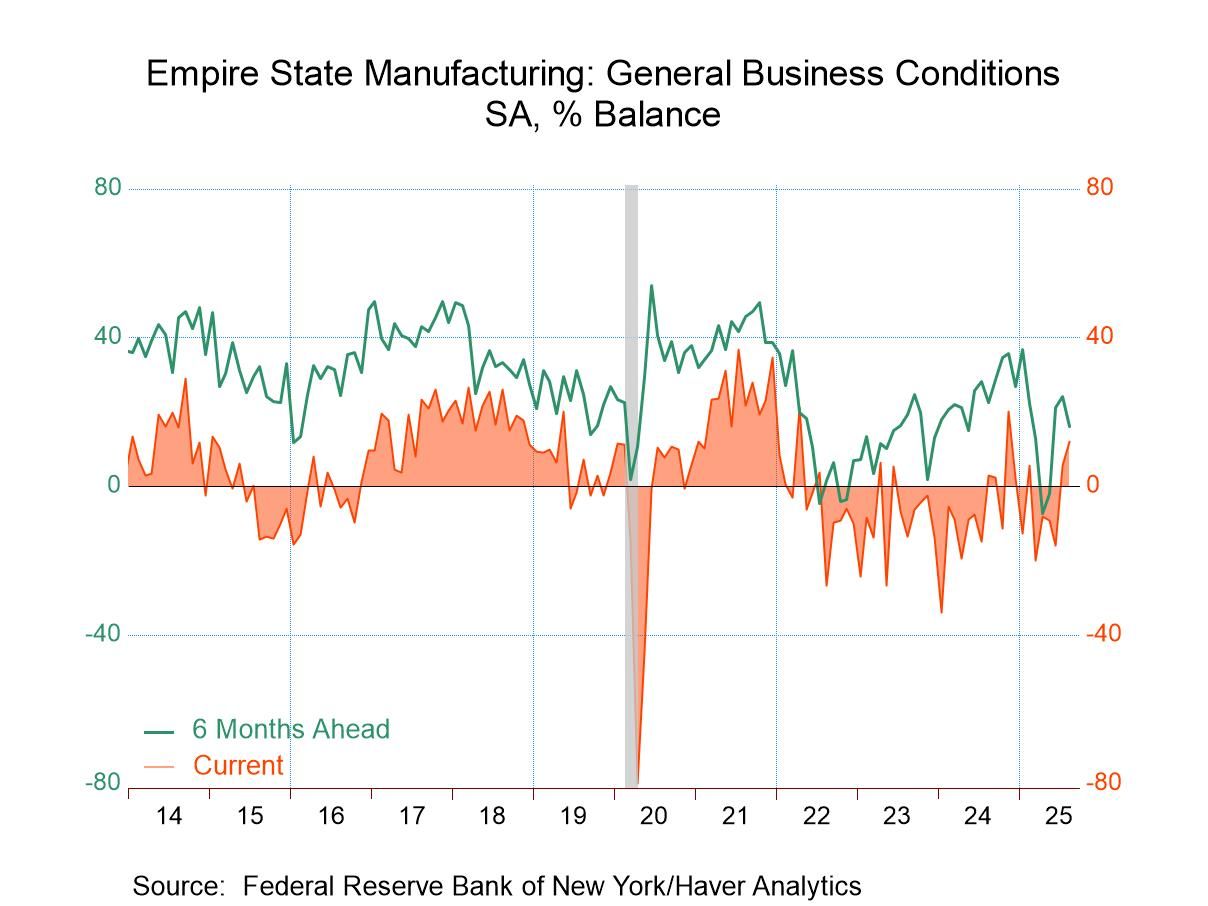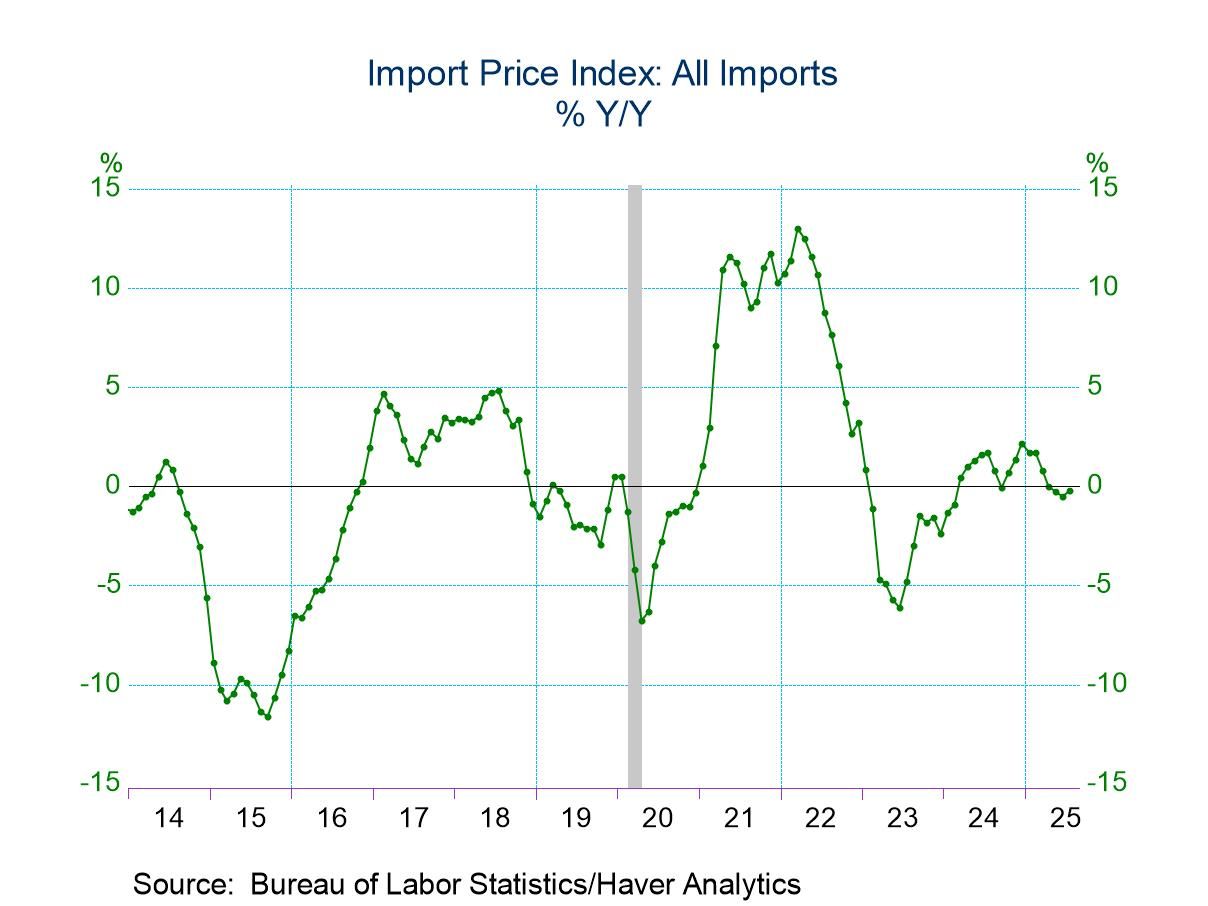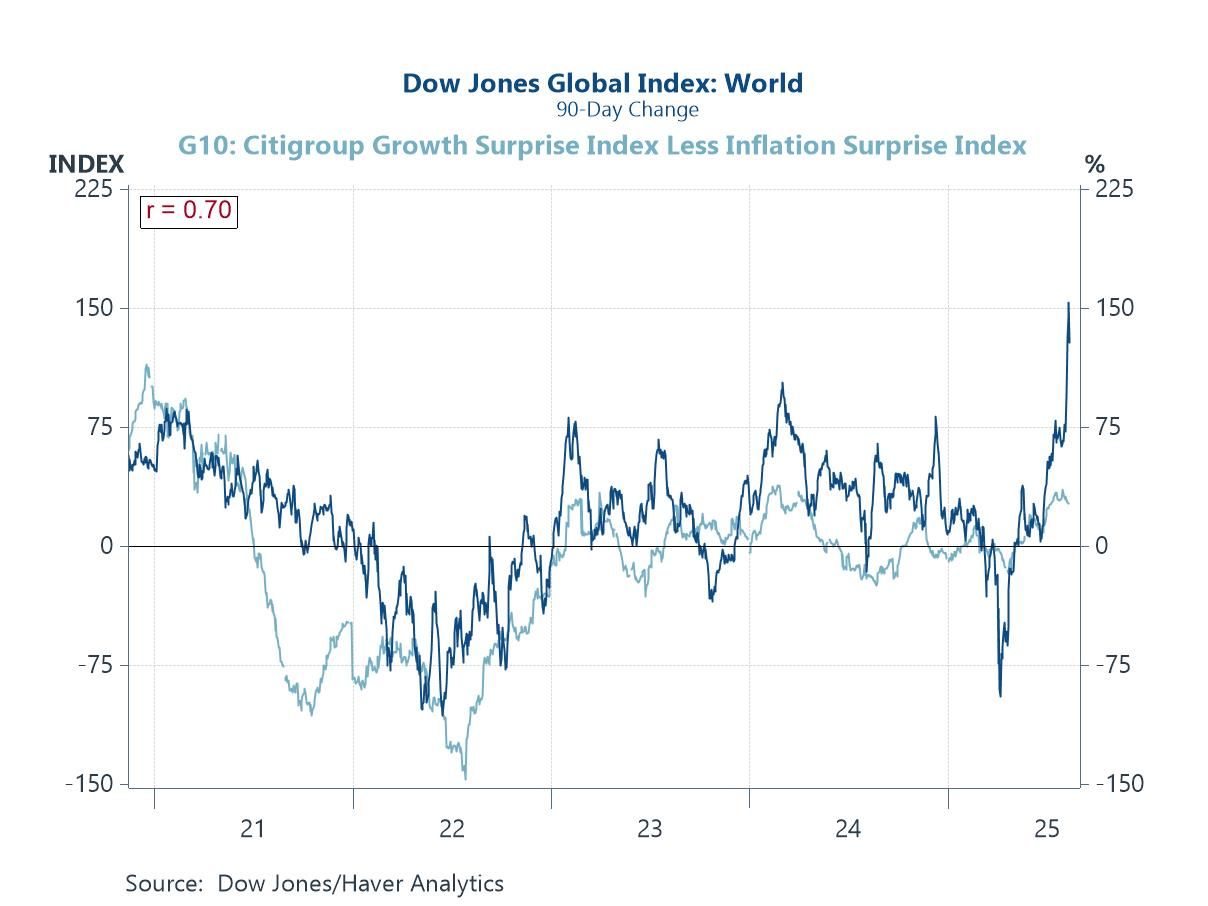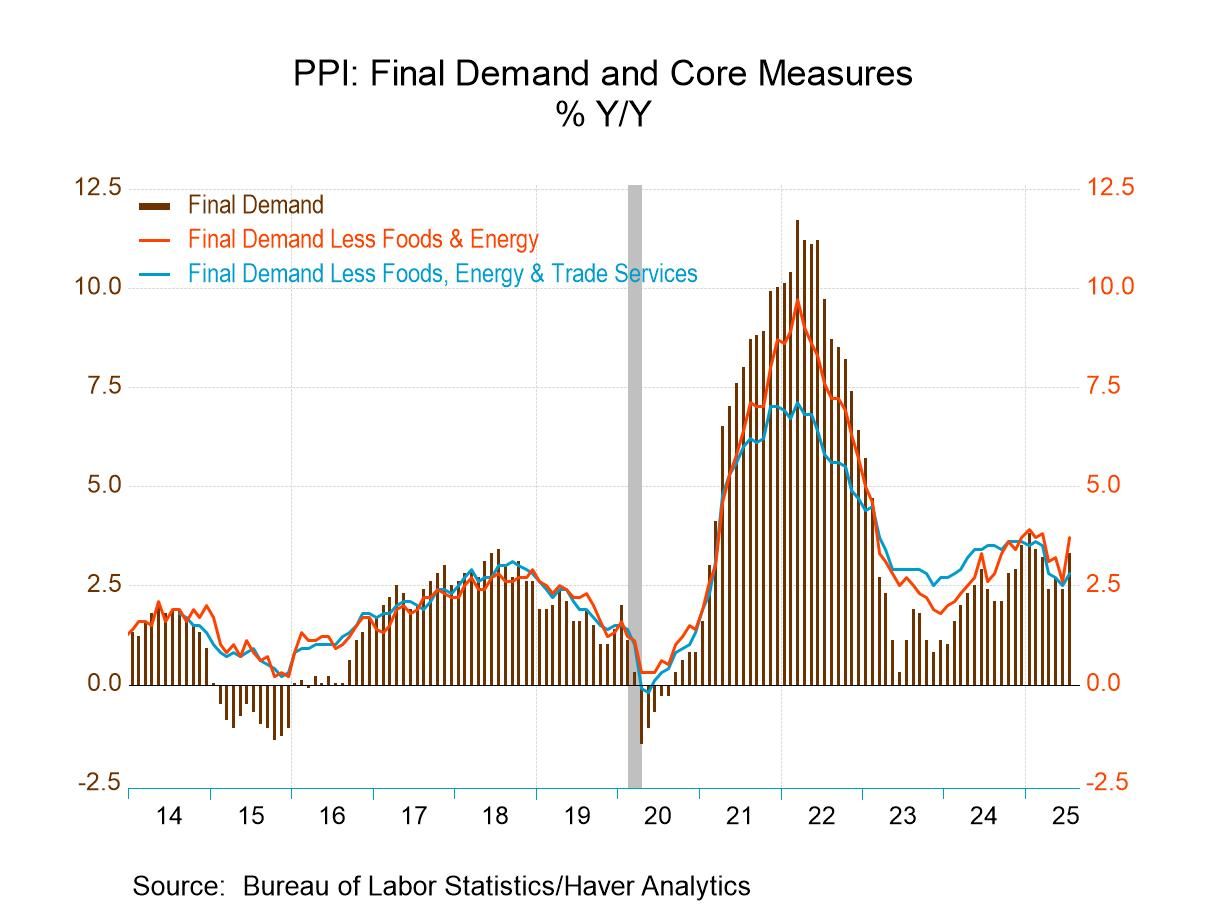 Global| Aug 11 2009
Global| Aug 11 2009U.S. Worker Productivity Jumps During 2Q As Trend Improves
by:Tom Moeller
|in:Economy in Brief
Summary
Businesses have managed their businesses well for the weakened economic environment. That's evident in the labor productivity gains during the last three quarters which stand in sharp contrast to the material declines during the [...]
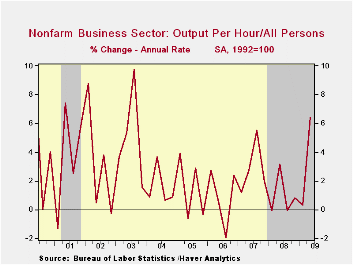 Businesses
have managed their businesses well for the weakened economic
environment. That's evident in the labor productivity gains during the
last three quarters which stand in sharp contrast to the material
declines during the economic downturns of the 1950s through the 1980s.
Last quarter, improved management of labor costs was evident in a 6.4%
(AR) surge in labor productivity in the nonfarm sector. It was the
strongest increase since the third quarter of 2003 and the gain beat
Consensus expectations for a 5.3% increase. (Revisions to past data incorporate
the comprehensive revisions to the National Income & Product
Accounts (NIPA) data that were reported on July 31st.
)
Businesses
have managed their businesses well for the weakened economic
environment. That's evident in the labor productivity gains during the
last three quarters which stand in sharp contrast to the material
declines during the economic downturns of the 1950s through the 1980s.
Last quarter, improved management of labor costs was evident in a 6.4%
(AR) surge in labor productivity in the nonfarm sector. It was the
strongest increase since the third quarter of 2003 and the gain beat
Consensus expectations for a 5.3% increase. (Revisions to past data incorporate
the comprehensive revisions to the National Income & Product
Accounts (NIPA) data that were reported on July 31st.
)
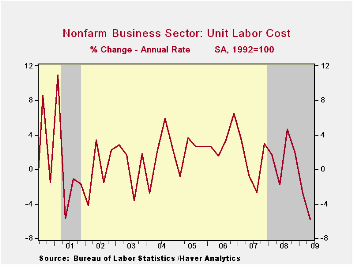 Cuts to employment & hours-worked
came in the face of a sharp output decline which totaled a record 5.6%
y/y. As evident in the recent GDP report, last quarter the quarterly
rate of business sector output decline slowed to 1.7% from 8.8% during
1Q. Nevertheless, businesses continued to cut employment &
hours worked sharply; at a 7.6% annual rate after a 9.0% drop during
1Q.· Compensation costs weakened substantially with the recession. They
barely rose at a 0.2% rate after the 2.4% 1Q decline. These weak
figures combined with downward revisions to earlier data leave the y/y
increase at just 1.3% which continues the downtrend from roughly 4.0%
growth back to 2001.
Cuts to employment & hours-worked
came in the face of a sharp output decline which totaled a record 5.6%
y/y. As evident in the recent GDP report, last quarter the quarterly
rate of business sector output decline slowed to 1.7% from 8.8% during
1Q. Nevertheless, businesses continued to cut employment &
hours worked sharply; at a 7.6% annual rate after a 9.0% drop during
1Q.· Compensation costs weakened substantially with the recession. They
barely rose at a 0.2% rate after the 2.4% 1Q decline. These weak
figures combined with downward revisions to earlier data leave the y/y
increase at just 1.3% which continues the downtrend from roughly 4.0%
growth back to 2001.
Last quarter, the surge in productivity and the moderation in labor cost growth combined to drop unit labor costs. The 5.8% q/q decline was the second in a row and lowered the y/y change to -0.6%, the first negative reading since early-2004.
Nowhere
was the productivity improvement more evident last quarter than in the
factory sector. 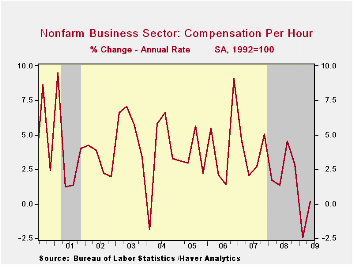 Worker productivity rose 5.3% which was the first
quarterly increase in over one year. Output fell at a 9.9% rate
(-15.0%) while hours worked dropped at a 14.4% rate (-13.9%). The
benefit to workers was seen in a 5.8% rise in 2Q compensation. That
rise lifted to y/y growth to 6.0% which was its strongest since 2003.
The combination of strong productivity and strong compensation kept the
quarterly increase in unit labor cost at just 0.5%. However,
year-to-year, growth of 7.4% y/y is a multiple of last year's 2.2%
growth.
Worker productivity rose 5.3% which was the first
quarterly increase in over one year. Output fell at a 9.9% rate
(-15.0%) while hours worked dropped at a 14.4% rate (-13.9%). The
benefit to workers was seen in a 5.8% rise in 2Q compensation. That
rise lifted to y/y growth to 6.0% which was its strongest since 2003.
The combination of strong productivity and strong compensation kept the
quarterly increase in unit labor cost at just 0.5%. However,
year-to-year, growth of 7.4% y/y is a multiple of last year's 2.2%
growth.
The productivity & cost figures are available in Haver's USECON database.
Investing over the life cycle with the long-run labor income risk from the Federal Reserve Bank of Chicago can be found here.
| Nonfarm Business Sector (SAAR, %) | 2Q '09 | 1Q '08 | Y/Y | 2008 | 2007 | 2006 |
|---|---|---|---|---|---|---|
| Output per Hour | 6.4 | 0.3 | 1.8 | 1.8 | 1.9 | 0.9 |
| Compensation per Hour | 1.2 | -2.4 | 1.3 | 2.8 | 4.2 | 3.8 |
| Unit Labor Costs | -5.8 | -2.7 | -0.6 | 1.0 | 2.3 | 2.8 |
Tom Moeller
AuthorMore in Author Profile »Prior to joining Haver Analytics in 2000, Mr. Moeller worked as the Economist at Chancellor Capital Management from 1985 to 1999. There, he developed comprehensive economic forecasts and interpreted economic data for equity and fixed income portfolio managers. Also at Chancellor, Mr. Moeller worked as an equity analyst and was responsible for researching and rating companies in the economically sensitive automobile and housing industries for investment in Chancellor’s equity portfolio. Prior to joining Chancellor, Mr. Moeller was an Economist at Citibank from 1979 to 1984. He also analyzed pricing behavior in the metals industry for the Council on Wage and Price Stability in Washington, D.C. In 1999, Mr. Moeller received the award for most accurate forecast from the Forecasters' Club of New York. From 1990 to 1992 he was President of the New York Association for Business Economists. Mr. Moeller earned an M.B.A. in Finance from Fordham University, where he graduated in 1987. He holds a Bachelor of Arts in Economics from George Washington University.



